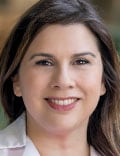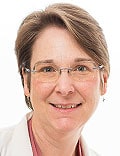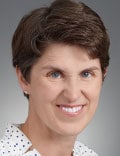LONG BEACH, California— Ms S had recently arrived home after a stay at a skilled nursing facility to recover from a hip fracture resulting from osteoporosis. For many patients, follow-up care would have included a DEXA scan or a prescription for a bisphosphonate from a primary care clinician not trained in geriatrics.
But the 85-year-old received care that went further and that is considered best practice for the management of geriatric fractures: A physical therapist visited her after discharge and provided education on the importance of maintaining mobility. Ms S also underwent assessment for fall risk and gait balance, and a team of multidisciplinary clinicians managed other factors, from postural hypotension to footwear and foot problems.

Dr Sonja Rosen
Sonja Rosen, MD, professor of medicine and chief of geriatric medicine at Cedars-Sinai Medical Center, Los Angeles, talked about Ms S as part of a panel discussion on applying the "Geriatric 5Ms" for patients with osteoporosis at the American Geriatrics Society (AGS) 2023 Annual Scientific Meeting.
"You have to figure out why they are falling and help them not fall again," Rosen said.
Approximately 10 million Americans have osteoporosis, and another 44 million have low bone density. One in two women and up to one in four men will experience a bone fracture as a result of osteoporosis, according to the Bone Health and Osteoporosis Foundation.
Geriatric healthcare providers view the 5Ms as core principles to be mindful of as their patients age ― mobility, medications, mind, multicomplexity, and matters most, which involves considering the care preferences and goals for healthcare outcomes of individuals.
Ms S eventually visited a geriatrician through the Cedars-Sinai Geriatric Fracture Program, which has been shown to lower costs and shorten hospital stays. In the program, she was advised to use a walker. Initially, she saw the aid as a hindrance ― she felt she should be able to walk without it, like before. But with education, she learned that it is impossible to predict falls and that the walking aid could reduce her risk of a stumble.
Rosen said clinicians should address any vision problems, prescriptions for psychotropic drugs ― which can affect balance ― and heart rate and rhythm abnormalities, and they should suggest modifications to the home environment, such as installing grab bars in showers and removing rugs that can easily be tripped over.
The program at Cedars-Sinai, like similar initiatives, offers a team with resources that some clinicians may not have access to, such as a care coordinator and bone-health coach. But healthcare providers can utilize aspects, such as making referrals to community exercise classes.
Rosen and her colleagues studied the effects of such exercise programs and found that the programs lessen loneliness and social isolation. Fear of falling decreased in 75% of participants, "which is so key to these post-fracture patients in getting back out into the world and engaging in their prior level of functional status," Rosen said.
The Second "M": Medication Management
The second "M," medications, can help clinicians sequence osteoporosis drugs, depending on patient characteristics and scenarios.

Dr Cathleen Colon-Emeric
Cathleen Colon-Emeric, MD, MHS, chief of geriatrics at Duke University School of Medicine, in Durham, North Carolina, dived into the case history of Ms S, who had hypertension and insomnia in addition to osteoporosis.
First-line treatment for Ms S ― and for most patients ― was an oral bisphosphonate, Colon-Emeric said. Compared with placebo, the drugs decrease the risk of overall osteoporotic fractures by nearly 40% (odds ratio, 0.62). But the medications are linked to injury of the esophageal mucosa. This risk is decreased when a patient stays upright for 30 minutes after taking oral bisphosphonates ― Colon-Emeric displayed a slide of a woman receiving a pedicure at a nail salon.
"The picture of the pedicure is to share the wonderful idea I got from one skilled nursing facility I was working with, who makes sure they do safe administration to prevent esophagitis in their patients by having them all go to a spa day, where they all sit up and get their nails done while they wait their 30 minutes [after taking the pill] sitting up safely," Colon-Emeric said.
This strategy drew applause from the audience.
Colon-Emeric advised that clinicians use judgment in the interpretation of results from the Fracture Risk Assessment Tool (FRAX). Incorporating race into estimates of fracture risk has pros and cons. While there are racial and ethnic differences in average bone density, the data for race calibrations to estimate risk are dated, she said. Clinicians should compare FRAX estimates with and without race input to help patients understand a range of risks.
Some patients may be reluctant to begin taking osteoporosis drugs because of misinformation originating from inaccurate news reports or anecdotes from friends. Colon-Emeric advised clinicians to remind patients that 1 in 5 who experience a fracture will have another injury in the following 2 years.
"A major osteoporotic fracture is akin to a heart attack; it has a very similar 1-year mortality rate and a very similar rate of a subsequent secondary event," Colon-Emeric said. "We have a class of medications that decrease both those risks by nearly a third."
Shared decision-making can help patients understand the risks and benefits of treatment, she said.
"People are really scared about the side effects," Michelle Keller, PhD, MPH, a research scientist at Cedars-Sinai who attended the session, said. "The ideas that a 'bone attack' is like a heart attack gets the message across."
Mind and Multi Complexity
Medical complexity of a patient must be considered when making decisions on treatment, according to Joshua Niznik, PharmD, PhD, assistant professor of medicine in the Center for Aging and Health at the University of North Carolina at Chapel Hill.

Dr Joshua Niznik
"Medical complexity is an acknowledgment of the entire person, the burden of their multiple chronic conditions, advanced illnesses, and also their biopsychosocial needs and how those together might augment treatment selection and decision-making," Niznik said.
Studies by Niznik and others have shown that swallowing difficulties, severe dementia, and being older than 90 are linked with a lower likelihood of receiving treatment for osteoporosis.
But therapies for fracture prevention, especially bisphosphonates, appear to be at least as effective for adults with medical complexity as they are for people without such conditions, Niznik said. Physicians must consider the potential treatment burden and the likelihood of benefit, he said.
Niznik's research has shown a lack of strong evidence of how clinicians can manage patients in nursing homes. In some cases, deprescribing is reasonable, such as for patients who have undergone treatment for several years and whose life expectancy is less than 2 years.
"In the absence of any of those, if they are not already treated for osteoporosis, it makes sense to initiate treatment at that time," Niznik said.
Matters Most: Patient Input
Clinicians need to educate patients on how long they must undergo a treatment before they experience benefits, according to Sarah D. Berry, MD, MPH, associate professor of medicine at Harvard Medical School, in Boston.

Dr Sarah Berry
A meta-analysis of studies that included more than 20,000 women who were randomly assigned to receive bisphosphonate or placebo found that one nonvertebral fracture was avoided during a 12-month period for every 100 persons treated. One hip fracture was avoided during a 20-month period for every 200 patients treated.
"In general, in persons with a 2-year life expectancy, time to benefit favors bisphosphonate use," Berry said. "Anabolics may have an even quicker time to benefit."
Berry said a shared a decision-making model can help clinicians facilitate discussions that help patients prioritize goals and compare options while considering results, benefits, and harms. And she offered a final tip: Use tools with absolute risk reduction to convey risks and benefits, as the relative risk calculations overestimate how effective treatment will be.
Rosen has disclosed no relevant financial relationships. Colon-Emeric has received grants from the National Institutes of Health and VA Health Services Research and Development Funding; has served as endpoint adjudication chair for UCB Pharma; and has received royalties from Wolters Klewer. Niznik has received funding from the National Institute of Aging and the Centers for Disease Control and Prevention. Berry has received funding from the NIH and royalties from Wolters Klewer.
American Geriatrics Society (AGS) 2023 Annual Scientific Meeting: Presented May 10, 2023.
For more news, follow Medscape on Facebook, Twitter, Instagram, and YouTube.
Credits:
Lead image: Dreamstime.com
Image 1: Senior Hebrew Life
Image 2: Duke University School of Medicine
Image 3: The University of North Carolina at Chapel Hill
Image 4: Harvard Medical School
Medscape Medical News © 2023
Cite this: Preventing Breaks and Falls in Older Adults - Medscape - May 15, 2023.











Comments